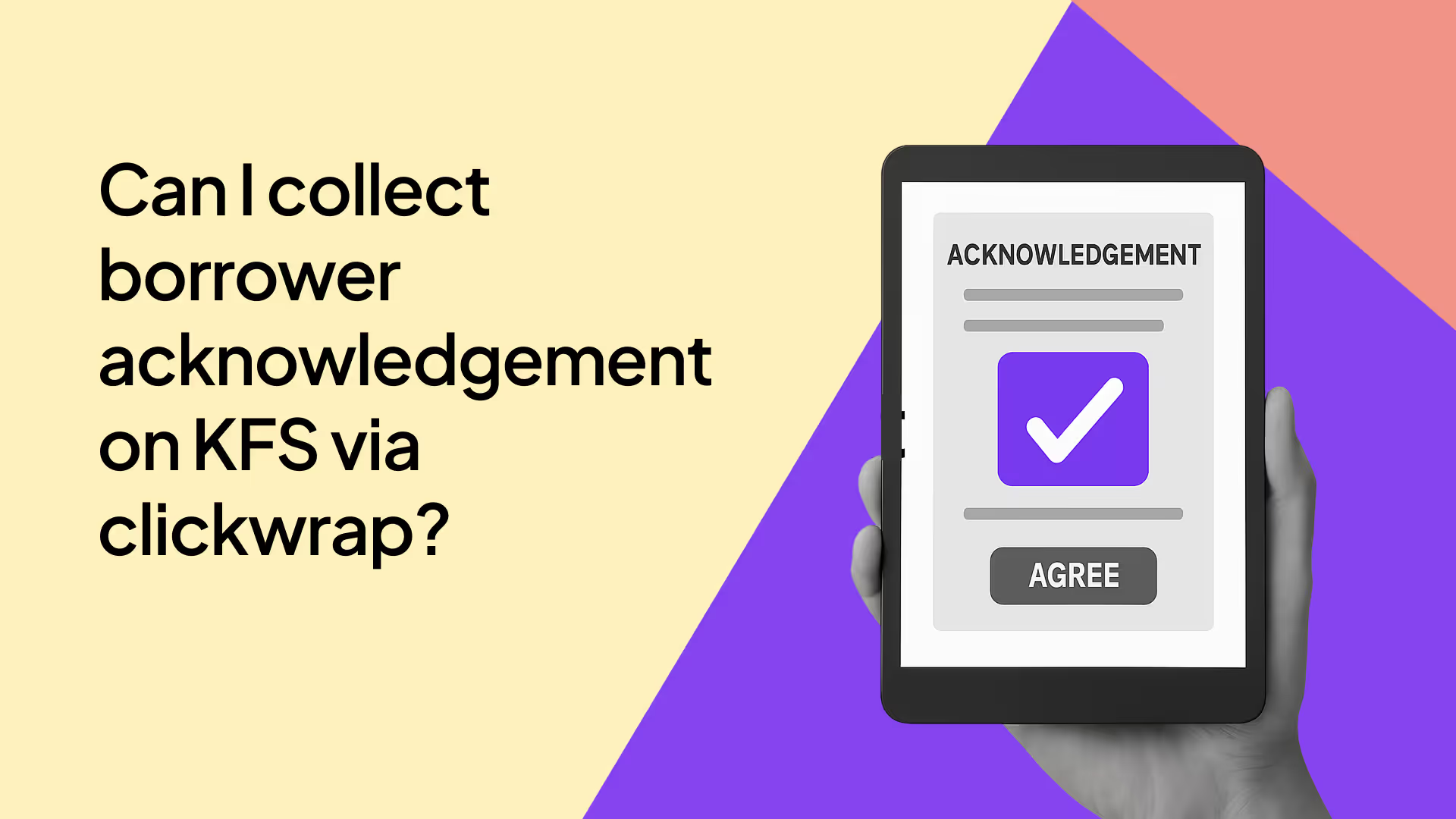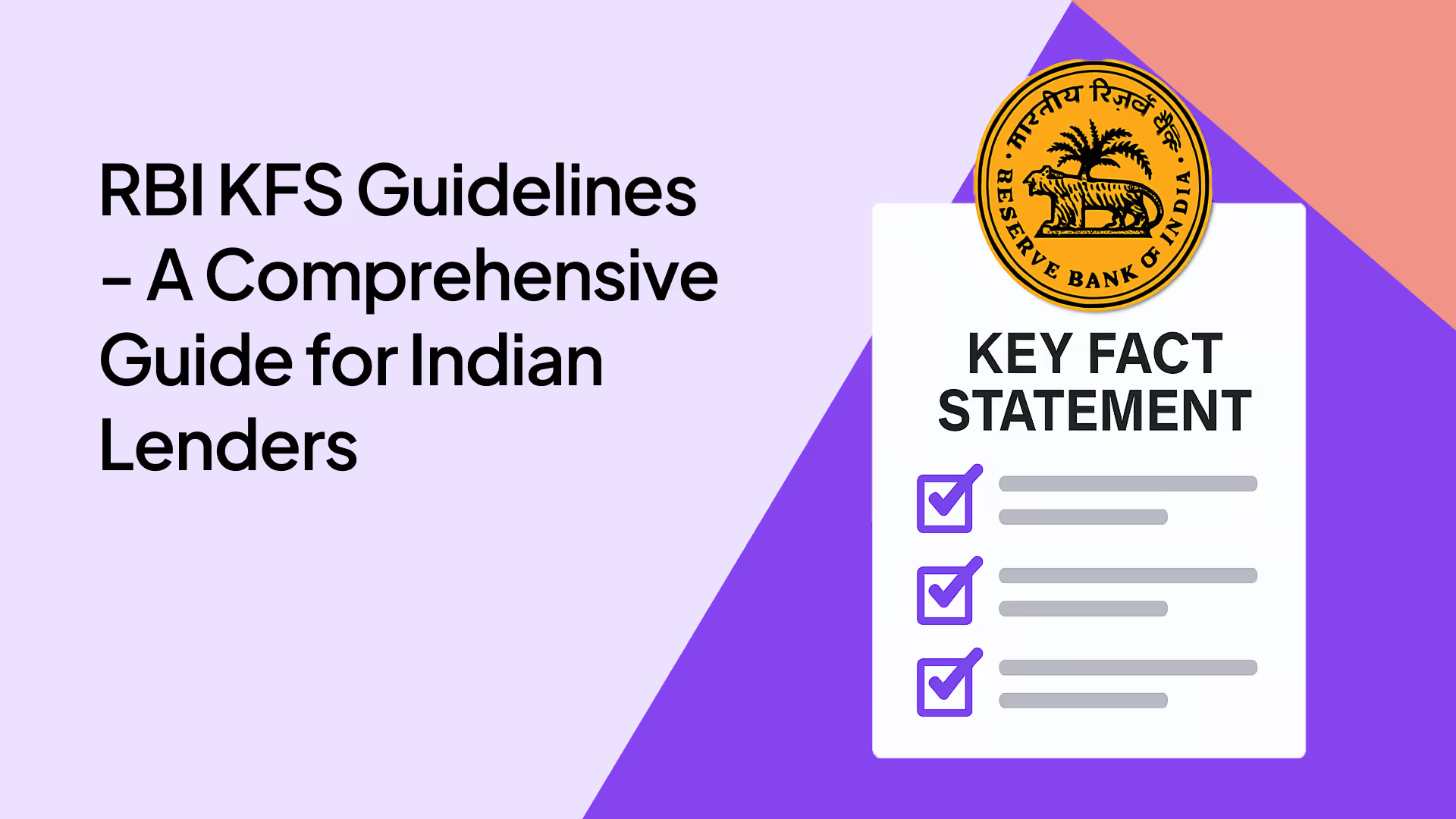As per the RBI Notification on Key Fact Statements (KFS) for Loans and Advances (“new KFS Rules”), lenders will need to “provide a KFS to all prospective borrowers…..before executing the loan contract”
For clarity, here’s the exact screenshot of this provision:

There is one core set of questions that arises here:
Do I need to get the KFS sent and acknowledged by the borrower BEFORE I even send out the loan contract for signing?
OR
Can I get the KFS and loan contract signed together - as long as KFS is the first document visible to the borrower in the document kit?
If the answer to question 1 is YES - then lenders need to modify their journeys and incorporate a new document signing flow for KFS.
If the answer to question 2 is YES - then lenders won’t need to add a new journey - but instead simply modify their existing document signing workflow.
In this article, we’ll try and answer these questions.
First let’s look at a scenario where this question does not even arise.
Scenario #1: If you get a sanction letter signed before the loan agreement then this question does not arise
In many lending journeys, particularly in secured loans like home loans or car loans, the sanction letter is the first document to be signed by the borrower. The sanction letter serves as a pre-approval for the loan, outlining the basic terms and conditions before the formal loan agreement is executed.
In these cases, the KFS can be included in the sanction letter kit. Once the borrower signs the sanction letter (which includes the KFS), the formal loan agreement can be sent later. This flow automatically ensures that the KFS is provided and acknowledged before the loan agreement is signed, 100% complying with the RBI’s requirements.
Here’s how it works:
- Before the RBI KFS Rules:
Sign the Sanction Letter kit → Sign the Loan Agreement kit (2 document executions) - After the RBI KFS Rules:
Sign the Sanction Letter kit + KFS → Sign the Loan Agreement kit (still 2 documents to execute)
Scenario #2: If you get sanction letter signed at the same time as loan agreement OR don’t have a sanction letter
In journeys like digital loans or micro-loans - the sanction letter is usually signed along with the loan agreement - as part of the same document kit. In some loan products - there isn’t any sanction letter.
In this scenario - the questions we asked above are highly relevant:
Do I need to get the KFS sent and acknowledged by the borrower BEFORE I even send out the loan contract for signing?
OR
Can I get the KFS and loan contract signed together - as long as KFS is the first document visible to the borrower in the document kit?
This is a call your compliance team will ultimately need to make.
We have seen both approaches being followed - let’s dive in.
Approach A: 100% undeniable compliance
Approach A is clear. The KFS is acknowledged by the borrower as a separate document kit from the loan agreement. Only once the KFS is acknowledged is the loan agreement sent to the borrower.
Here’s how the flow works:
Insert Flow Image from Deck
In Approach A:
- The borrower will have to perform 2 different “signing” actions. One for acknowledging the KFS and the other for signing the loan agreement.
- The lender will need to send the KFS and loan agreement to the borrower as 2 different document kits - and ensure KFS is acknowledged first
- In a digital journey - the lender gets undeniable proof that the KFS was sent and understood by the borrower before loan agreement was executed
There is no doubt or ambiguity with Approach A. It is 100% compliant with the new KFS Rules.
Most BFSI companies that we are working with are opting for approach A - since it is compliant with the RBI rules in both letter and spirit.
Approach B: Compliant in letter? But not in spirit?
In Approach B the KFS is sent as part of the same document kit as the loan agreement. However the KFS is the first document visible in the kit.
Once the borrower has read and understood the KFS - they can sign the entire document kit together.
This approach relies on the fact that the borrower must “see and understand” the KFS before execution of the loan agreement.
Since the KFS is being sent as top of the loan kit - and before execution of the loan agreement - the borrower is definitely afforded the opportunity to examine KFS before execution of the loan kit.
Here’s how the flow works:
Insert Image from Deck
In Approach B:
- The borrower performs a single signing action - for the KFS and the loan agreement together
- The lender sends KFS and loan agreement as a single document kit
- The KFS will be acknowledged at the same time as the loan agreement is executed - so digitally it won’t be possible for the lender to show the RBI that the KFS was understood before
There is some ambiguity and doubt about Approach B. While some lenders are following it - there is doubt about whether it is compliant in spirit with the new KFS Rules.
Give me a summary - KFS to be signed before or after?
Here’s a summary of the options we’ve discussed in this article:
Scenario #1: Sanction Letter Signed Before Loan Agreement
If your sanction letter is signed before the loan agreement - then include the KFS in the sanction letter kit. The KFS is signed before the loan agreement, ensuring full compliance with the RBI rules.
Scenario #2 (Approach A):
- Send the KFS and loan agreement as separate document kits, with the KFS acknowledged first.
- The borrower will need to do 2 acknowledgements/eSigns
- This approach ensures 100% compliance in both letter and spirit of the RBI rules.
Scenario #2 (Approach B):
- Include the KFS as the first document in the same kit as the loan agreement.
- The borrower will need to do a total of 1 eSign for both documents
- While this approach might be compliant in letter, there is some doubt about its compliance in spirit. It’s a simpler workflow but carries some risk.
In Scenario 1 and Scenario 2A - make sure to ALSO put the KFS as first part of loan agreement
Clause 9 of the new RBI KFS Rules states that the KFS should be included as a summary box as part of the loan agreement:

What this means is that the KFS acts as a summary of the loan - and should also be produced as part of the loan agreement kit.
So in Scenario 1 and Scenario 2A - where KFS acknowledgement is happening before loan agreement execution - you still need to include a copy of the final KFS as part of the loan agreement kit.
Note: Clause 9 does not mean a summary of the KFS. It means that the full KFS acts as a summary of the loan - and must be included as part of the loan agreement kit.
Can Leegality help me comply with the new KFS Rules?
Yes we can. We are already working with 15+ Banks and NBFCs to build RBI-compliant digital KFS flows.
Check out our KFS Page - where you can do the following:
- Book a 45 minute digital KFS demo
- Do a 2.5 minute digital KFS journey demo yourself without getting on a call with us
Here’s the link once more - KFS Page

.avif)


